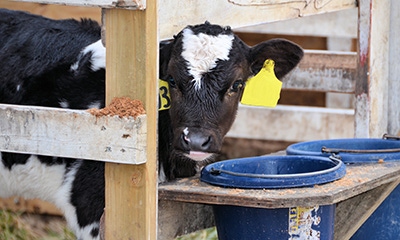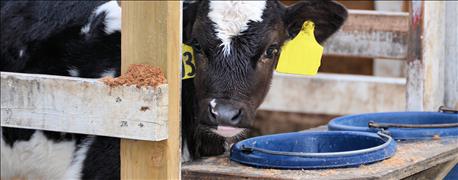January 19, 2016

If you think weather extremes make it tougher for humans to stay healthy, try coping with the wide temperature swings and wet weather as a four-footer in dairy facilities.
This winter’s extremes are causing a spike in cattle stress and pneumonia cases in the Northeast and Mid-Atlantic. Experts at Penn Vet’s New Bolton Center have seen an increase in pneumonia cases, ranging from sudden death of apparently healthy animals to chronic illness and poor production, particularly in growing heifers and calves, and in adult cows.

KEEP ‘EM CALF-COMFY: While young stock will grow thick coats, little calves are less cold tolerant, and will appreciate a calf coat and extra milk when it’s cold, says Hain.
While these weather challenges aren’t as catastrophic as the blizzards out West, they can significantly impact productivity and herd health. Dr. Meggan Hain, staff veterinarian in Penn Vet’s Field Service and the Marshak Dairy at New Bolton Center, offers five important tips for preventing and addressing pneumonia in dairy cows.
Good air: The most important measure in preventing pneumonia is good ventilation. While our instinct is to close everything up and batten down the hatches in winter, this can be significantly detrimental to air quality and cooling capacity, particularly on warm days, notes Hain.
Open the curtains: On warm, humid days, don’t forget to open the curtains to allow plenty of air flow. If in doubt, open everything up. Remember, these animals are wearing their winter coats.
Open windows: Open any windows or vents that have been closed to allow good air flow. Opening up barns as much as possible to prevent stagnant areas is essential. In this unusual weather, heifers housed outdoors with a run-in shed tend to do better than those housed indoors, due to better ventilation.
Forced ventilation: For older barns, consider putting in forced ventilation, adding fans as a quick fix in a pinch.
However, use fans with caution to avoid chilling young calves. A better solution is a well-designed tube ventilation system. A well-designed ventilation system that can be adjusted to fit most barns. Penn Vet’s Dr. Billy Smith is a qualified consultant who can design one for your facility.
~~~PAGE_BREAK_HERE~~~
Air-quality and air-flow testing: For the best results, consider having an air-flow and air-quality test run on your facilities under normal working conditions. This includes monitoring air quality at the animal level (for calves, often at the straw level), and air flow throughout the barn. Penn Vet’s Field Service can perform these tests.
Vaccinations: The key to using vaccinations as prevention is to give the vaccination before the disease challenge. The best way to have a vaccine program that works well for your farm is to consult with your veterinarian, who can develop a program that will be both effective and practical.
Target your vaccinations. Consider adding pneumonia-specific vaccinations just before the most challenging times of early and late winter to provide extra protection for your animals. Some intranasal vaccines are particularly helpful as they provide a better localized immunity in the airways. Again, talk with your vet about which vaccine combinations and routines would work best.
Healthy patients: Make sure that the animal is healthy when it receives the vaccination so that it can mount a good response. And make sure the vaccine is handled appropriately. Vaccinations that haven’t been kept cold, are expired, are poorly mixed, or are administered with old or dirty equipment are ineffective.
Avoid added stress: The unusual weather is already adding stress. So during this time, avoid transporting the animals, excessive intermingling or bringing in new stock from outside sources or sale barns.
Closely monitor: Catching an illness early give the best chance of effective treatment and prevention of long-term damage. During your chores, don’t forget to to take the time to watch the animals and look for signs of illness. Watch for animals that are isolating themselves or slow to join the group, droopy ears, sunken eyes, lying down with a dull attitude, poor condition, as well as snotty noses, coughing, and increased respiratory effort and rate.
~~~PAGE_BREAK_HERE~~~
If you suspect an animal is ill, take its temperature. Normal temperatures should be 100.5 to 102.5 degrees Fahrenheit. Consult your veterinarian for treatment protocols. Consider posted protocols so you are ready to respond to a problem when it arises, or call your vet for case-specific advice.
Facing an outbreak: Sometimes, despite your best efforts, you’ll face a disease outbreak. Fast and aggressive treatment is the key to success.
Treat affected animals early and aggressively to prevent long-term lung damage. Consider isolating them to prevent disease spread and to help monitor their feed intake and progress. Treating to decrease fever with an anti-inflammatory, and possibly supportive fluids, will help to make the animal feel better, eat better and heal faster.
No article on pneumonia would be complete without mentioning blanket treatments, including feed through antibiotics such as the tetracycline crumbles. These treatments can be effective in helping to address an outbreak in a large group. Use these only under the consultation of your veterinarian, as these products are coming under stricter scrutiny by U.S. regulators.
Vaccinations? Even in the face of an outbreak, consider vaccinating healthy animals to help prevent disease spread, suggests the Penn Vet dairy specialist. Vaccinations add stress to the immune system and take time to provide protection. But when used cautiously, they can help in an outbreak situation. In particular, intra-nasal vaccinations tend to provide quicker respiratory system immunity.
Winter weather is typically good for herd health and high milk production, as the big rumens in dairy cows constantly generate heat, and their large bodies preserve that heat. “Occasionally, with extreme cold, we’ll see issues with frostbite on teats,” adds Hain. “This can easily be remedied with a good teat dip.
You May Also Like




